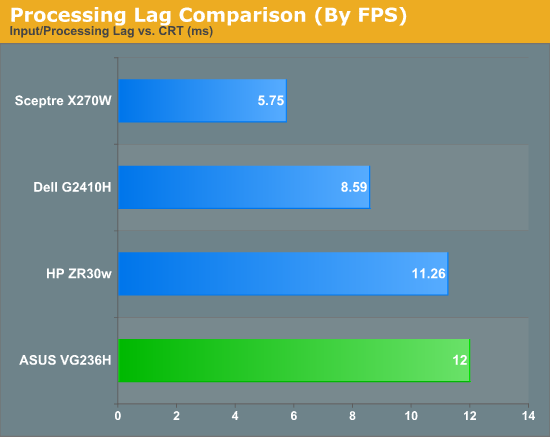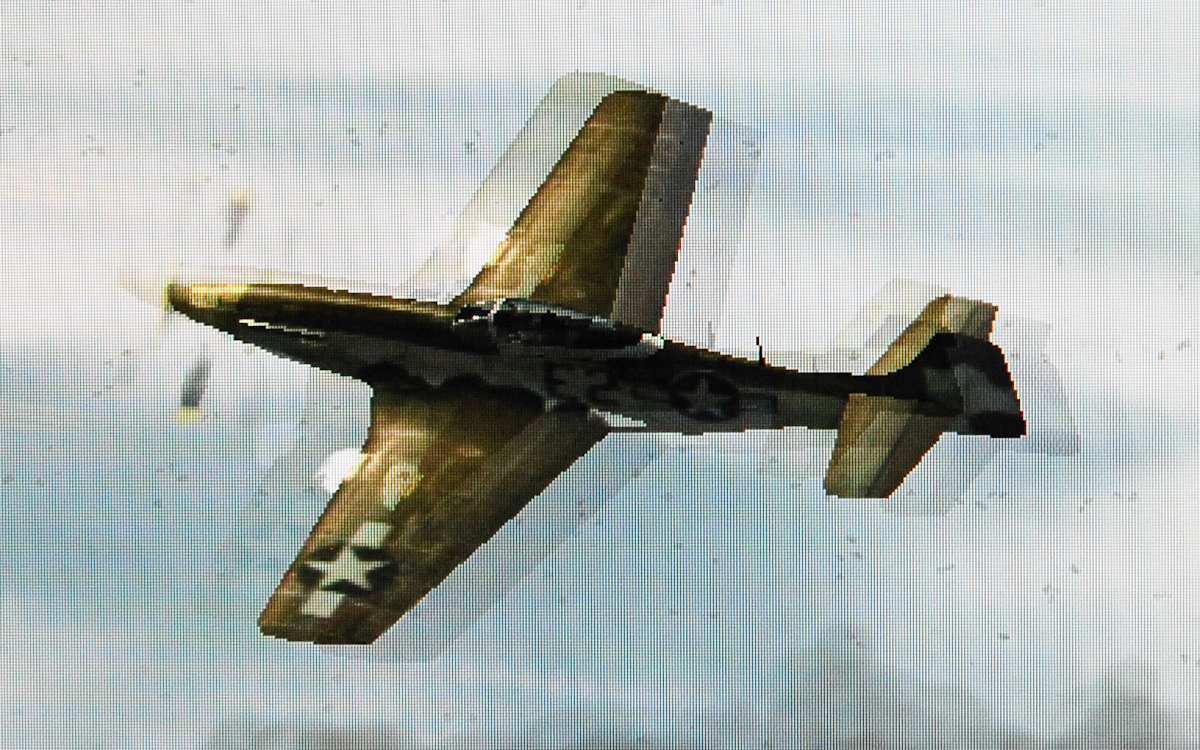ASUS VG236H 23-inch 3D Display Review: 120Hz is the Future
by Brian Klug on August 7, 2010 2:48 AM ESTProcessing and Input Latency
Processing and display lag is a very important thing for gamers, and it’s most often nebulously reported if at all. We’ve discussed this in previous display reviews, but what matters most is how the display acts in real world testing. I’ve been doing previous tests by comparing LCDs with first a 17” Princeton CRT, then a Sony G520 20” CRT.
So far the results have been a bit interesting, with the CRT barely edging out over the LCD. I did the same thing with the VG236H.
Jarred and Anand both warned me right after my first attempt with this method that we were probably going to see a difference purely because we’re comparing an analog VGA signal for the CRT to the DVI signal for the LCD in test. The problem being that because of the way we test, it’s likely the VGA and DVI paths get different frames from the framebuffer entirely. In addition, because I had the Zotac GTX 470 instead of the ATI Radeon HD5870 like previous tests, there’s another element of change here.
I ran through the tests as usual and measured the difference between the CRT at 75Hz (its maximum, seriously), and the VG236H at 120Hz running the 3Dmark Wings of Fury benchmark on constant loop. The ASUS comes in about 12ms behind the CRT after collecting 14 different samples.

I used the VG236H to play a number of FPS games during my time with it, and never noticed perceptible input lag. I’m convinced there’s something else at play here.
Remember how I mentioned the display has overdrive, er... “trace free” controls? By default, outside of 3D mode, trace free is set to 60. I decided to test at 100 and 0, effectively with overdrive on maximum, and off entirely. Turning overdrive off adds a repeatable 2.2ms of display latency after 20 data points.
More importantly, it effectively reduces the number of ghost images captured from two (one trailing, one preceding), to one (just trailing). Now you can understand why ASUS probably sets overdrive to maximum in 3D mode and keeps you from touching it, to virtually guarantee no ghosting or weird artifacts.
While we’re on that subject, I’ll note that I only noticed ghosting once while playing Metro 2033 start to finish in 3D with the VG236H, and even then I first thought it was something reflecting weird in the glasses. I’ve read about other displays having very obvious ghosting - you’d be hard pressed to find that with the VG236H.
I wasn’t entirely convinced that the VG236H had more input lag than any display I had tested previously, so I decided to test against a display I’m pretty fond of - my BenQ FP241W. Now, what about how the VG236 compares to it?
The VG236H consistently lags 1 frame from the FP241W, regardless of FPS, across about 40 photos I captured of the two displays. It’s always exactly one frame behind.
So what does that mean? Well, we’re likely seeing the difference between the 60Hz refresh rate of the FP241W and the 120Hz refresh rate of the VG236H. The higher refresh rate lets the ASUS show more frames than the FP241W, giving us more granularity. It just so happens that it’s pulling one frame behind, which on average worked out to a lag of 1.9 ms.
Further, Jarred tested the FP241VW which is essentially the exact same monitor as the FP241W but in a different enclosure, and measured input processing lag to be 2 ms compared to the famous HP LP3065 (which has no scaler and no input lag). Thus, a more accurate number for input lag on the ASUS VG236H is the sum of the two, at a much more respectable 3.9ms.













121 Comments
View All Comments
B3an - Sunday, August 8, 2010 - link
Is 120hz possible on a 2560x1600 monitor? As the res is the highest a DVI dual-link cable can handle, and i'm not sure if the latest Display Port or HDMI specs have enough bandwidth for 120hz at this res? Anyone know?mac2j - Sunday, August 8, 2010 - link
Is 120HZ possible on a 2560x1600 ?Yes. And personally I agree that would be my dream also ... although we're probably talking ~$2000. The mostly likely place to look would be Dell's next revision of the 2008WFP.
The other consideration is you'd need a serious graphics card to drive 3D at that resolution with that framerate .... really with the current offerings you're probably looking at needing the top 1 or 2 models in SLI for good performance.
I have a rudimentary understanding of where monitors excel in relationship to TVs in this area but can anyone tell me what kind of performance/picture you could expect using one of the new 240Hz 3D TVs as a monitor?
mac2j - Sunday, August 8, 2010 - link
Ugh type I meant 3008WFP ... need edit button...DarkUltra - Sunday, August 8, 2010 - link
No you need DisplayPort to get 2560x1600 at 120hz. Dual link DVI maxes out at about 1300p 120hz. If you have such a high resolution and lack the 3d perfromance, why not run games at half, say 1280x800. Fonts in Windows look real nice in high dpi on my crt (1530p 134dpi)mac2j - Monday, August 9, 2010 - link
OK here's the breakdown as far as I can tell:Regular DVI & HDMI <1.3 max out at 1920x1200x60Hz.
Dual-link DVI maxes out at 1920x1200x120Hz
HDMI 1.3 & DisplayPort 1.0 max out at 1680x1050x240hz
1920x1200x140hz or 2560x1600x120hz would require DisplayPort 1.2 or HDMI B (which may become 1.5)
Nothing I've heard of can handle 2560x1600x240hz as far as I know (would require =24 Gbit/s capacity)
mac2j - Monday, August 9, 2010 - link
Its worth mentioning that as far as I know the first commercial cards to support DisplayPort 1.2 will be the ATI 6000 series late this year but I could be wrong.B3an - Monday, August 9, 2010 - link
I've got two 5870's and they run pretty much everything at 2560x1600 no problem, even with AA + AF... not really anything these days that really stresses cards like games used to, too much console port crap. Also had a single GTX480 and that could get way over 60+FPS at this res with 98% of games.So after looking into it... mac2j is right, Display Port 1.2 should definitely be able to do 2560x1600 @ 120hz.
Just hope the 3008 replacement can do 120hz, but i highly doubt it will, these monitors are not really for gamers, even though it would benefit other things too...
ralgha2001 - Monday, July 11, 2011 - link
I know this may be a dumb question.. but could I use a Samsung 40" Full HD TV (S-PVA supposedly 4 ms response) @ 120 hz for gaming and have 1920x1080 @ 120 hz (it has HDMI and RGB inputs). I don't quite care about 3D but I would like to know if I could do gaming on this and skip buying a new monitor for now..I'm actually building a new rig from ground zero. I'm thinkin in nvidia's GTX 580 and a mobo for the intel 1155 socket (maybe along the 2500K to save some bucks from 2600K). Since detailing the other components might not be needed or care about I'm stopping here.
But I'm not sure if i should go for the AW2310 or another current monitor since I might still be able to go with my HDTV and save a bunch. Doesn't seem like an actual option since nobody seems to mention it and still wonder in with monitors @60 hz.
Thanks!
TareX - Sunday, August 8, 2010 - link
Any shutter glasses system is not the future.The future is autostereoscopic lenticular lens 3D screens.
bill4 - Sunday, August 8, 2010 - link
I think you guys play fast and loose with the input lag tests. It's great that you do them though, dont get me wrong.For one thing as far as I know, turning almost any processing on only increases lag. For that reason I'm rather doubtful turning overdrive on reduced lag. I mean think about it, if the display has to process the image in any way, you're adding lag.
Next you mention some monitor that you claim has no scaler and no lag. Well again as far as I know, ANY LCD display inherently has lag. So again I'm rather dubious.
In total, it reads like you wanted this monitor to have low lag, because you liked it so much, so you sort of brushed aside evidence otherwise.
I dont understand how in the same article you run a test apparently showing it to have 14 ms lag, then later claim it has 3.9 ms by comparing it with some third monitor. It just doesnt make sense, and is confusing at the least. Which test do you consider definitive? And if this third LCD has no lag, why didn't you test it versus a CRT? Simply having no scaler is not proof it has no lag.
I mention this because in the HDTV lag thread at AVS forums, it's a generally accepted tenant that 120hz displays have more lag than 60 hz ones. That's why I would expect this 120hz display to have relatively more lag, such as your first test seemed to hint at.